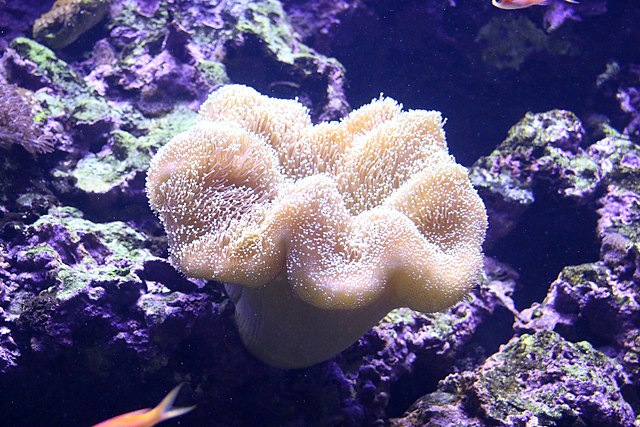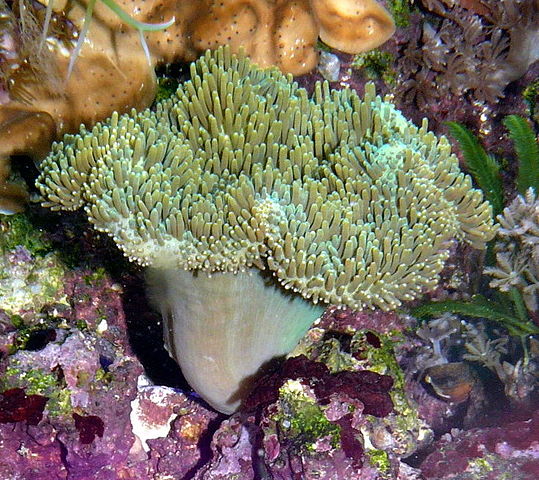
A Sarcophyton is a soft coral that is commonly called a Toadstool Leather. These are popular for reef tanks due to their hardiness, low cost and availability.
They are called toadstools because they look like a mushroom. They have a stalk and an umbrella shaped top. The top of the coral is called the capitulum. As these corals mature, their umbrella top can become more wavy. Some species can almost resemble a wavy bowl if you are looking down on them.
Their polyps also vary based on which species. Some are short and others are long. These polyps will wave back and forth in the current which makes them interesting to look at in a reef tank. Typically the polyps are extended when lights are on, and they are retracted during night time.
Most toadstool leathers are tan to creamy brown in color. But you can find them in shades of yellow, pink, and green. As long as you find a color that you like, these corals should make a great addition to your reef tank.
Most of the time, you will see them listed as (Sarcophyton sp.) and they will not have a specific name. There may be some specific types like the Sarcophyton elegans that you can find. This has a beautiful yellow color.
These corals are native to Indonesia, Australia, and Tonga. Most species that you for sale are likely aquacultured. Leather corals are very easy to propagate.
- Genus: Sarcophyton
- Phylum: Cnidaria
- Family: Alcyoniidae
Table of Contents
Types Of Toadstool Leather Corals
Toadstool Mushroom Leather

The standard Toadstool coral usually comes in shades of tan or white. You can find these in most brick and mortar stores that sell corals. These are also available in big box stores due to their ease of care and hardiness. Big box pet stores typically do not carry difficult corals.
You may also see this listed as a mushroom coral. These are the standard species, and they are usually the least expensive.
Green Toadstool Mushroom
While most Sarcophyton corals are cream, white or tan, you can get a green variety that comes from Tonga. This is more difficult to obtain, and they seem to be a little more sensitive than other leathers. If you are a beginner, you should try one of the other strains.
The base of the coral is green, not the polyps.
Sarcophyton Elegans Yellow Leather Coral
The Elegans yellow leather is different than other sarcophytons. It does not have a stalk, and it grows close to its base. It get beautiful ruffles around the edges. It is different than other leather corals because it is a bright yellow color. Most are a tan or cream color.
Long Polyp Leather Coral
Toadstool corals come in many sizes, colors, and shapes. This also includes tentacle and polyp length. Sometimes, you will see some named Long polyp because they have extremely long polyps that flow back and forth. Typically, these will have long tan colored stalks with white polyps.
Green Polyp Mushroom Coral
The Green Polyp Leather is different because it has a cream or white base with green colored polyps. Mushroom corals with green polyps are a little harder to acquire, and they cost more than your standard version.
While the polyps are green for this strain, you can find different color options ranging from tan to pink to purple for the base and stalk.
Weeping Willow Toadstool Leather
The Weeping Willow coral is different because it has long polyps that stay out and drop down when there is no flow. This is because the polyps are extremely long at over 4 inches. It resembles the tree with the same name. This is not a strain that you can go to a store and obtain. The Weeping Willow leather coral was made known by Jake Adams at reef builders.
Leather Coral Placement
You can place a Toadstool Leather Coral on live rock in the middle to upper area of the aquarium as long as they receive moderate flow and medium-to high lighting. This is the best area of the tank for a leather coral to thrive.
Toadstool Coral Care
Toadstool leathers are easy to care for because they are hardy. They are not hard to keep, and are a great option for any skill level reef tank owner.
- Care Level: Easy
- Lighting: Moderate to High
- Flow: Medium to Strong
- Temperature: 72-78 Fahrenheit
- dKH: 8-12
- pH: 8.1-8.4
- sg: 1.023-1.025
Toadstool Corals will grow fast if you have a healthy tank with proper flow and lighting. These can grow fast and you should see a noticeable difference from a small frag in less than six months.
Water Flow
These corals prefer moderate to high flow. They are fairly rigid on their stem so they can tolerate greater movement. If you have a leather that is unhappy, try moving it to a place in your tank that has better water movement.
Lighting
Toadstool corals, like all leathers, can tolerate a wide range of lighting. They tend to do better in moderate to high lighting, but it is not necessary. You should be able to place them where you like in your tank. As long as you have good lighting, it should thrive. They will do well with all lighting including LED’s, metal halides and T5.
Feeding
Sarcophyton leather get their food from photosynthesis. The symbiotic zooxanthellae hosted in their body provides the main source of its nutrition. It can benefit from additional foods like phytoplankton or other filter foods. In addition to your reef lights, it is a filter feeder.
Toadstool Leather Coral Growth Rate
Toadstool leathers will grow quickly in the right environment. If they are in a stable reef tank with great lighting, they can get big. They may go through a time where there is little to no growth, but then they grow quickly.
If you are not seeing a lot of growth out of your mushroom leather, then it may need more light. Leather corals seem to grow faster with a higher level of light on them.
Shedding
Like other leather corals, the Toadstool Leather coral can shed the outer layer of its skin. This helps to remove the top layer of their tissue that may have detritus or algae on it.
The coral will retract its polyps. This can last for days. It will have a shiny and waxy appearance for a little while. It will rid itself of this out skin, and it will look better once the shedding process has finished. The leather will extend his polyps again once shedding is complete.
It has been noted by other reefers that the waxy coating that is shed can irritate other corals. I have never seen this in any of my tanks. The key here is proper placement and flow. You can also watch it closely and use a net to capture any of the sloughed skin.
Toxicity
Toadstool corals are toxic and can release toxins or chemicals into the water to keep other corals from encroaching on their territory. It is a defense mechanism to keep other corals away. They are not out actively trying to kill other species.
You can easily counter the chemical warfare from leather corals by not placing them close to others, and you can run activated carbon. Carbon will adsorb any toxins from your water. I have multiple leathers in my tanks, and I have never had an issue with them getting along with others. As long you keep them isolated, it should not be a problem. This is no different than understanding placement of corals with sweeper tentacles.
Summary
Toadstool corals (Sarcophtyon) are great corals for any reef tank. They work great with other leather corals like Sinularia or Finger Leather coral. While they are often seen as a beginner coral, a lot of experienced reef tank owners do not keep them in their tanks.
They do seem to be getting more popular lately, especially the not so common strains like the green polyp mushroom.
featured image via Cangadoba, CC BY-SA 4.0 https://creativecommons.org/licenses/by-sa/4.0, via Wikimedia Commons
